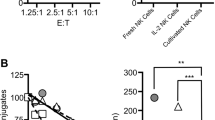Abstract
Adherent cells from carcinomatous pleural effusions of lung cancer patients were tested for their ability to suppress natural killer (NK) cell activity, and the mechanism involved in the suppression of NK cell activity was determined. Adherent effusion cells (AEC) were isolated from malignant pleural effusions of patients by centrifugation discontinuous Ficoll-Hypaque gradients and adherence to serum-coated plastic dishes, and large granular lymphocytes (LGL) were purified from the peripheral blood of normal individuals by centrifugation on discontinuous Percoll gradients and further depletion of high-affinity sheep erythrocyte rosette formation. LGL-mediated lysis of K562 cells was suppressed when LGL were cultured with AEC for 20 h, then washed and tested in a 4-h 51Cr release assay. More profound suppression of NK cell activity was observed when cytotoxicity was assayed in flat-bottomed wells rather than in round-bottomed wells. Cytotoxicity assays conducted at the single cell level in agarose revealed that the frequency of LGL binding to K562 cells and of dead conjugated target cells was reduced after overnight contact with AEC. In agarose microdroplet assays, functional LGL from normal donors exhibited definitive motility, expressing polarized shape. In contrast, a small number of LGL with non-polarized configuration migrated from the agarose droplet after overnight culture with AEC. These results indicate that functionally suppressed NK cells lose their motility, binding capacity and killing activity, which could be responsible for the suppression of NK cell activity by AEC.
This is a preview of subscription content, access via your institution
Access options
Subscribe to this journal
Receive 24 print issues and online access
$259.00 per year
only $10.79 per issue
Buy this article
- Purchase on Springer Link
- Instant access to full article PDF
Prices may be subject to local taxes which are calculated during checkout
Similar content being viewed by others
Rights and permissions
About this article
Cite this article
Uchida, A., Colot, M. & Micksche, M. Suppression of natural killer cell activity by adherent effusion cells of cancer patients. Suppression of motility, binding capacity and lethal hit of NK cells. Br J Cancer 49, 17–23 (1984). https://doi.org/10.1038/bjc.1984.4
Issue Date:
DOI: https://doi.org/10.1038/bjc.1984.4
This article is cited by
-
Influence of natural killer cells and perforin-mediated cytolysis on the development of chemically induced lung cancer in A/J mice
Cancer Immunology, Immunotherapy (2014)
-
Vimentin in cancer and its potential as a molecular target for cancer therapy
Cellular and Molecular Life Sciences (2011)



